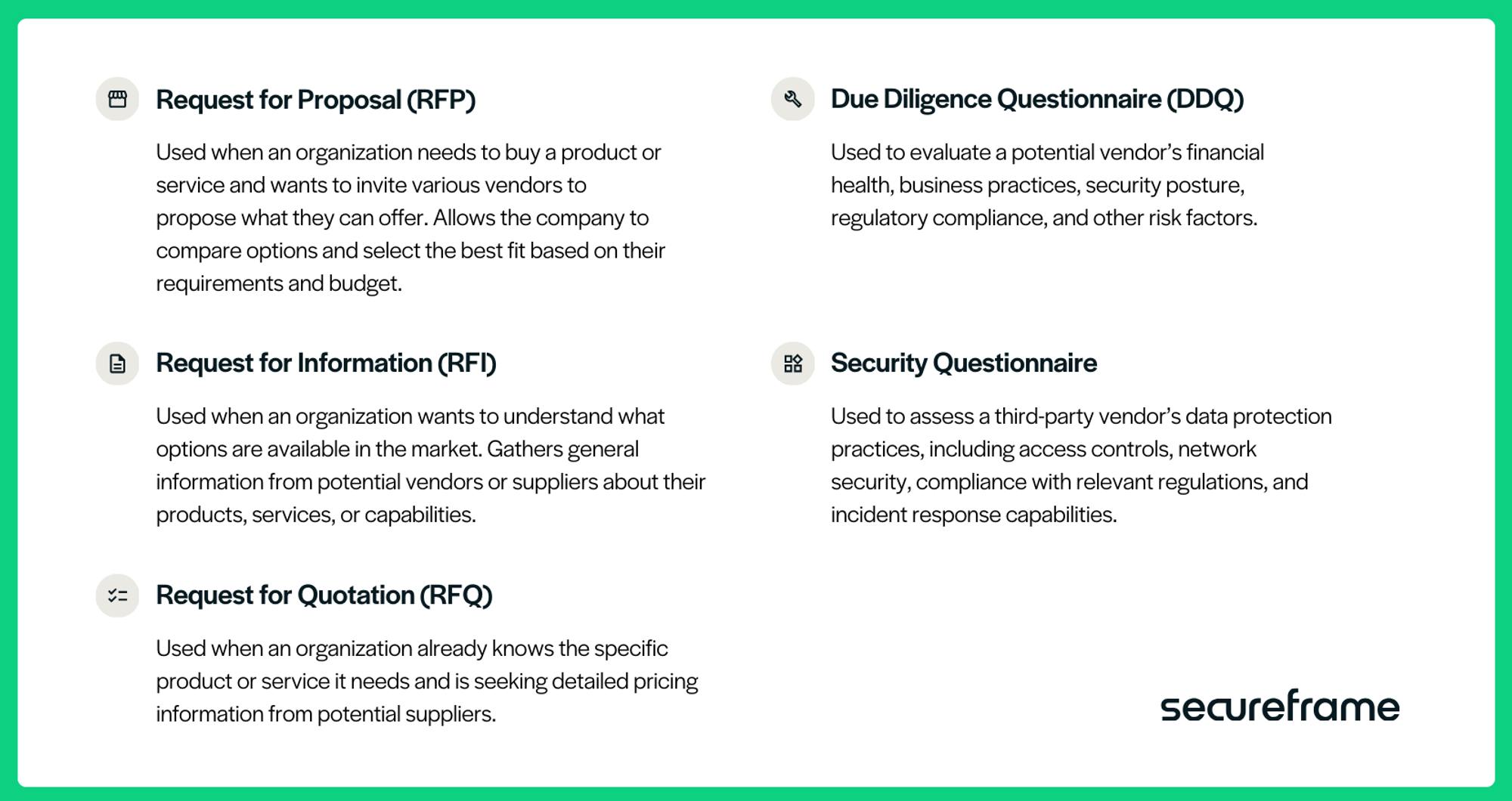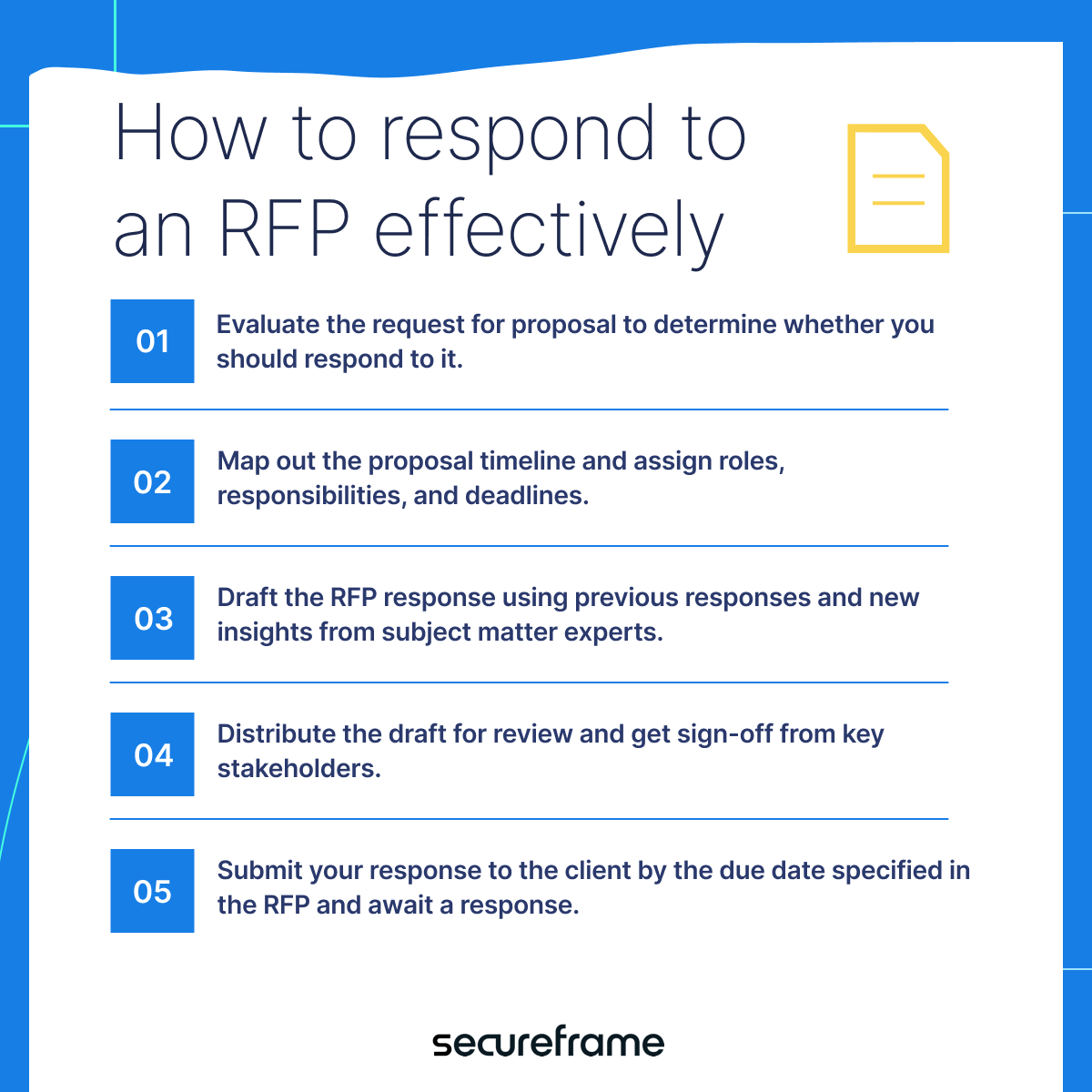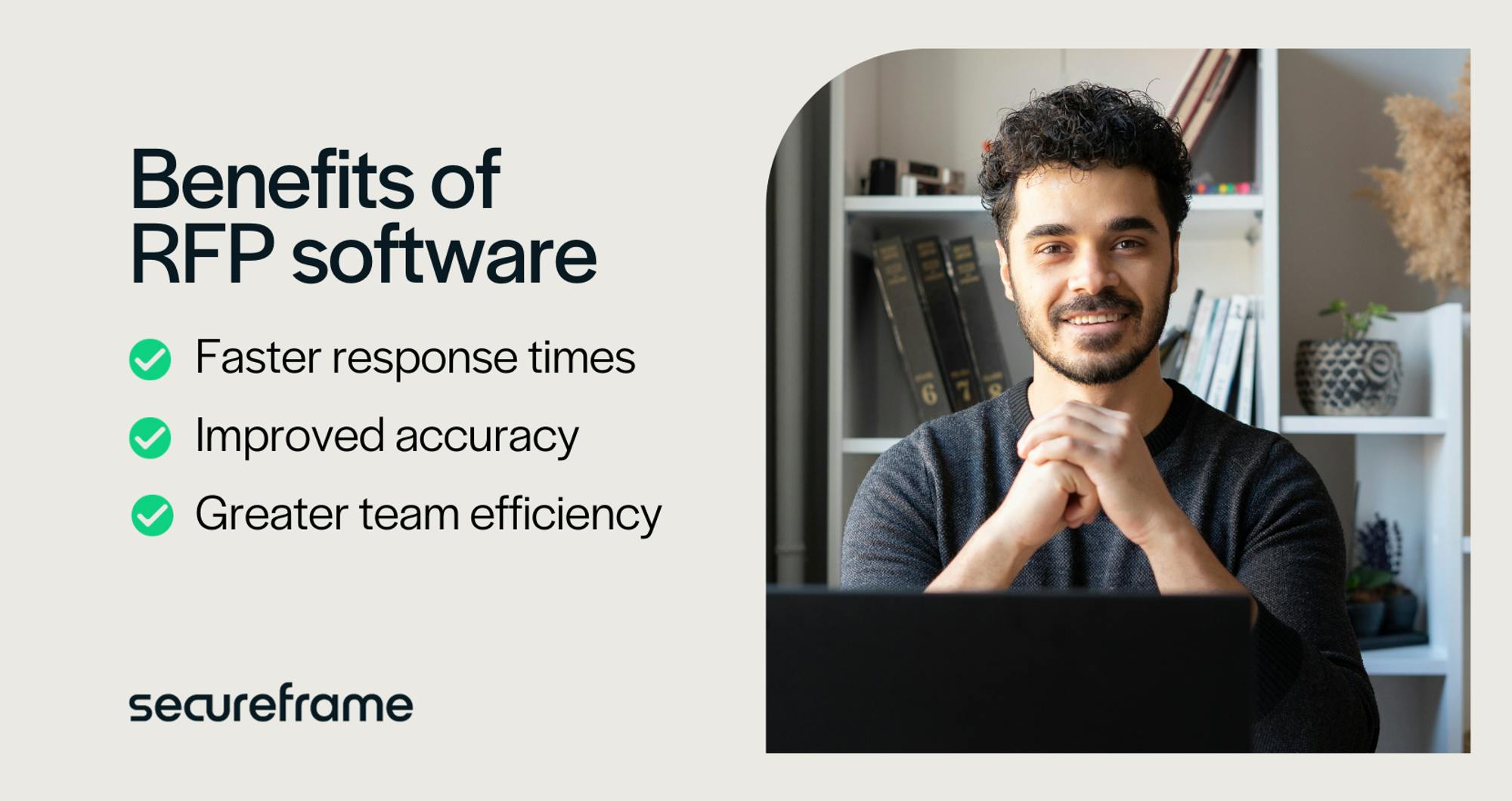Example request for proposal response
Table of Contents
What is an RFP response?
RFP response process
How to respond to an RFP
RFP response best practices
RFP response template
RFP response software
Speed up the RFP response process with AI

How to Write a Winning RFP Response + Free Template
Senior Content Marketing Manager at Secureframe
Senior Content Marketing Manager at Secureframe
The average request for proposal (RFP) includes 77 questions, and each question takes approximately 25 minutes to answer. That means it takes an average of 32 hours to respond to a single RFP.
Now imagine you get multiple RFPs a week. Responding to them is highly manual, tedious, and time-consuming. Having a standardized process in place can help save your team valuable time, improve the quality of your RFP responses, and win over more new clients.
To help you simplify the RFP response process and improve your win rates, we’ll outline a step-by-step process, explain how RFP software can streamline your efforts, and provide request for proposal templates.

What is an RFP response?
A request for proposal (RFP) is a common step in the vendor procurement process. It’s an effective tool for companies to learn about multiple vendors and select the one that best meets their needs.
An RFP response is a bid from a qualified vendor or contractor to complete a project that was publicly announced and described in an RFP or RFI (request for information). This response should show that your organization can meet the client’s criteria for skills, budget, and timeline, among other factors.
Essentially, an RFP is an organization saying, “We need a vendor to help us do XYZ.” Companies issue an RFP and various vendors submit their bid through an RFP response, which explains how the vendor can meet that need and why the organization should choose them over the competition.

Recommended reading

What is a Request for Proposal? + Template
The RFP response process
An RFP response process is a set of interrelated and repeatable steps you follow to respond to an RFP. This process can help you determine which RFPs are worth responding to, assign deliverables and deadlines to the right people, and ensure you submit a draft that’s already been reviewed and proofread by the due date.
Having a standardized process can ensure that RFPs are responded in a consistent way, even as your organization grows and looks to take on more clients.
Let’s take a look at the individual steps involved in the process below.
How to respond to an RFP
Follow the step-by-step RFP response process below to showcase how your organization can meet the client's needs.

1. Evaluate the RFP
The first step is to evaluate the RFP to ensure you understand exactly what the client is looking for and decide whether you should respond to it. Based on the scope of work, you may determine that it’s not a good customer fit or that you don’t have the resources to complete the project on the expected timeline. Or perhaps the return on investment will likely be lower than the cost of completing the project. Whatever the reason, you can decide not to respond, saving your team valuable time and resources.
If you determine it is a good opportunity for your organization, then you can continue on to the next step.
2. Map out the proposal timeline and assign deliverables
To ensure you submit the RFP response in a timely manner, it’s important to clearly assign roles, responsibilities, and deadlines.
While there are different project management approaches you may take, a common methodology is to break down each task required to complete the RFP response into individual steps and assign an owner and due date or milestone for each.
For example, the task of evaluating an RFP may be broken down into several steps, like:
- Reviewing and summarizing the RFP by a proposal manager and account executive
- Making the go or no-go decision after consulting with legal, finance, and an executive stakeholder
- Creating and publishing a proposal timeline with the proposal manager
3. Draft the RFP response
Write the cover letter
The cover letter accompanies your RFP response and is the first document the reviewing team will see. It’s a crucial introduction to your company and a valuable opportunity to highlight any unique qualifications or expertise that make your organization the best fit.
Here’s what you should include in your RFP cover letter:
- Brief introduction: Include your company name and contact info, and a short statement about your organization’s qualifications. Clearly state that your letter is in response to the specific RFP you’re answering and include the RFP title and/or reference number.
- Summarize your proposal: Give an overview of your proposal, highlighting how it meets the specific requirements outlined in the RFP. Demonstrate a clear understanding of the client’s goals, challenges, and requirements.
- Detail the attachments: Mention that your detailed proposal is attached, along with any other relevant documents, case studies, or materials.
Keep your cover letter concise and professional. Make sure you proofread for any spelling and grammatical errors, and follow any formatting or submission guidelines specified in the RFP.
Write the executive summary
The executive summary offers a brief overview of your proposal, highlighting the key points and making a compelling case for why your organization is the best choice for the project. It should highlight how well you understand the client's needs, your proposed solution, and the unique benefits or value your company brings.
Here’s what to include in your executive summary:
- Key Requirements: Begin by demonstrating a clear understanding of the challenges or requirements outlined in the client’s RFP to shows the client that you have thoroughly digested their requirements and are responding specifically to their situation.
- Proposed Solution: Outline your proposed solution or approach. This should be a high-level overview, focusing on how your solution addresses the client's needs and the outcomes you expect to achieve. Pay special attention to the Scope of Work section of the submitted RFP when specifying your deliverables and implementation plan.
- Differentiators and Value Proposition: Highlight what sets your proposal apart from the competition. This could be your company's unique expertise, innovative approach, cost-effectiveness, superior technology, proven track record, or any other factors that give you an edge.
- Benefits to the Client: Clearly articulate the benefits the client will receive by choosing your solution. These benefits should be direct responses to the client's objectives and pain points as outlined in the RFP.
- Call to Action: Conclude with a statement that encourages the client to read the detailed proposal and a note of readiness to discuss any aspects in further detail or clarify any points.
The executive summary should be concise, usually no more than one or two pages. However, it should be complete enough that if a decision-maker reads only the executive summary, they will grasp the essence of your proposal and its primary advantages.
Explain pricing and contract terms
Explaining pricing and contract terms in an RFP response requires detail and transparency. Here’s a list of information to include:
- Clear Breakdown of Costs: Provide a detailed breakdown of the costs associated with your proposal. This can include one-time costs (like setup or installation fees) and recurring costs (like monthly or annual service fees). Clearly explain what each line item covers to help the client understand exactly what they’re paying for.
- Total Cost of Ownership: If applicable, discuss the total cost of ownership, which includes not only the initial costs but also any ongoing maintenance, support, or operational costs.
- Value Proposition: Explain how your pricing correlates with the value you are providing. If your solution offers benefits like increased efficiency, reliability, or innovation, make sure to highlight these. If your solution is more expensive than some alternatives, justify the additional expense by highlighting the superior benefits or long-term savings.
- Flexible Pricing Options (if applicable): If there are different service levels or optional add-ons, lay these out clearly. This can include tiered pricing, discounts for longer commitments, or additional services at extra cost.
- Contract Terms:
-Duration: Specify the proposed contract length and any terms related to renewal.
-Termination Clause: Outline the terms under which either party can terminate the contract.
-SLAs and Performance Metrics: Include any service level agreements (SLAs) or performance metrics that you commit to.
-Payment Terms: Detail the payment schedule, invoicing procedure, and any late payment policies.
- Customization and Scalability: If your pricing can be customized based on the client’s specific needs, make that clear. And be sure to discuss how costs will be affected if the scope of the project expands.
Add social proof and case studies
As an attachment, include any success stories from clients that are similar to the new business you’re trying to win — highlight organizations from similar industries, company size, business challenges, and use cases. Testimonials from real customers can offer a compelling argument in your favor and give prospects a clearer idea of the value your company delivers and what it’s like to work with your team. Even better if you can provide contact information for a customer that’s willing to serve as a referral and speak to potential clients directly.
When drafting an RFP response, you can likely repurpose some answers from previous responses. You may see repeat questions asking about your firm, team structure, related project experience, and project approach as well as references and a cost proposal.
You will likely also need to consult subject matter experts for net new content or for help tailoring responses to the specific client. For example, responses to security and IT questions may require input from your CISO or information security team members.

4. Distribute the draft for review.
Before you submit your response to the client, you should get input and sign-off from key stakeholders in business operations, marketing, IT and security, finance, and legal, plus at least one executive decision-maker.
5. Submit your response to the client.
Before the due date specified in the RFP, submit your response to the client. Be sure to follow up with the customer to ensure they received it and answer any questions they may have.
8 Tips for writing a winning RFP response
When responding to an RFP, you’re likely competing against several vendors. What can you do to ensure your response stands out from the crowd? Here are best practices for writing a winning proposal that leaves potential clients with a stellar first impression.
- Follow the client’s instructions: Make sure you respond to all required questions and follow the submission instructions specified in the RFP. Instructions might dictate the length and format of your RFP response, when it should be submitted, and more.
- Focus on the client’s needs: Every section of your RFP response should be dedicated to proving how your organization’s proposed solution is the best choice to meet the client’s needs. Make sure to continually reference the RFP and requirements outlined in that document when writing your response.
- Customize your proposal response to the client: While you can repurpose answers from previous RFP responses, you should take the time to tailor the response to the unique client and requirements of their RFP. Position your features around their current pain points, use client-specific visuals, and reference the prospect’s needs as directly as possible.
For example, you can customize your company’s boilerplate messaging to mention the client specifically. Say Secureframe was responding to an RFP. Instead of saying, “Our company can help companies of all sizes achieve and maintain compliance with rigorous global standards,” we might say “Our company can help ABC Company achieve and maintain SOC 2 compliance.”
- Be specific: Be as specific as possible in your RFP response. After reading your response, the client should understand what tasks you are able to complete, how you plan to complete them, by what date, and with what budget.
- Include visuals: When possible, use visuals like charts and graphs to make your response more engaging and memorable. Customize your visuals to the potential client whenever possible.
- Share industry and security certifications: Be sure to mention your level of compliance with any applicable industry or regulatory requirements and security frameworks such as SOC 2, ISO 27001, and PCI DSS. If compliance involves an annual audit or certification, include the issue date or audit window.
- Automate your RFP response process: Automation can significantly speed up the RFP response process by suggesting answers based on previously answered RFPs, enabling you to assign subject matter experts to individual questions, and keeping an up-to-date knowledge base of previous responses.
These tips can help you write high-quality, effective RFP responses that clearly demonstrate why your organization is the best fit for prospective clients.
RFP response template
Download this free RFP response template to get a better understanding of what prospective clients might ask when trying to evaluate vendors and how you should answer. This can help you respond to RFPs faster and easier and increase your win rates.

Improve your win rates with RFP response software
Responding to RFPs is an important part of winning opportunities with new organizations, but it can eat up valuable time and resources for startups and large enterprises alike.
Some questions are the same from customer to customer and require you to repeat yourself or track down previous responses. Some questions vary from customer to customer with no standardized format, set, or order of questions, which means you need to bring in subject matter experts to repeatedly answer questions or update previous answers.
RFP response software can help automate the process, save time, and improve the overall quality of your RFP responses.

- Save time: Maintain a single knowledge base to improve response accuracy and speed up the RFP response creation process. AI and machine learning capabilities allow you to automatically include the best answers to fill out an RFP or security questionnaire quickly and easily.
- Improve team efficiency: RFP automation tools store the best content used in responding to previous proposals. By answering a question once in the knowledge base, your senior staff and subject matter experts can avoid fielding a flurry of incoming questions and focus on high-priority tasks.
- Avoid mistakes: Automation ensures all your RFP answers will be accurate and up-to-date.
With RFP software, you won’t have to spend hundreds of hours of manual work assigning incoming RFP questions to subject matter experts, combing through documents and folders to find previous responses to RFPs, and then copying and pasting them into the new proposal.
Instead, RFP software like Secureframe Questionnaire Automation and Knowledge Base can:
- Suggest responses based on previously answered RFPs using AI and machine learning
- Store previous responses in a knowledge base, which you can use to auto-populate future questionnaires
- Automatically update answers in the knowledge base as new responses to RFPs are finalized
- Allow you to assign subject matter experts to edit answers in an RFP response or knowledge base
- Export the completed proposal to the original format to send back to your prospective client
With Secureframe’s questionnaire automation, you’ll get hundreds of hours back to focus on other high priorities. And because you’ll be able to complete RFPs in less time, you’ll be able to edge out the competition and increase your win rates.
Automate the RFP response process with the power of AI
We built Secureframe Questionnaire Automation and Knowledge Base to make it fast and easy to respond to RFPs using artificial intelligence (AI).
Simply upload an RFP or security questionnaire to Secureframe, verify Secureframe’s suggested answers from the Secureframe Knowledge Base, and export the completed document in the original format to send back to your customer.
Schedule a demo of Secureframe Trust to see Secureframe Questionnaire Automation and Knowledge Base in action.
Use trust to accelerate growth
RFP Response FAQs
How do you write a response to an RFP?
- Read the RFP Carefully: Understand every requirement and question in the RFP. Pay attention to the details about the scope of work, deliverables, timelines, and evaluation criteria.
- Understand the Client's Needs: Understand their industry, challenges, values, and what they are likely looking for in a vendor. Tailor your response to align with their needs and goals.
- Assemble the Right Team: Ensure that the people who are knowledgeable about the topics addressed in the RFP are involved in preparing the response. This may include subject matter experts, project managers, finance professionals, and legal counsel.
- Outline Your Response: Start with an outline that maps your response directly to the requirements in the RFP. Make sure to cover all the points and questions raised in the RFP document.
- Develop a Compelling Executive Summary: This is often the first section read, so make it engaging and concise. Summarize your key value propositions and how they align with the client's needs.
- Address the Requirements: Clearly and thoroughly respond to each requirement in the RFP. Be specific about your capabilities, experience, and approach to meeting these requirements.
- Highlight Your Differentiators: What sets you apart from your competitors? This could be your expertise, unique methodology, innovative solutions, superior customer service, or any other factors that give you an edge.
- Provide Concrete Examples: Use case studies, client testimonials, or specific project examples to demonstrate your experience and success in similar projects or challenges.
- Be Clear and Concise: Avoid jargon and overly technical language unless it is industry-appropriate and necessary. Make your proposal easy to read and understand.
- Price Competitively: Provide a pricing structure that is competitive and clear. Ensure that your pricing model aligns with what's requested in the RFP (e.g., fixed cost, time and materials, etc.).
- Review and Edit: Proofread your proposal for any errors. A well-written, error-free proposal reflects your professionalism and attention to detail.
- Follow Submission Guidelines: Adhere to the format, length, and other submission guidelines outlined in the RFP. Submit your proposal on time and in the correct format.
- Follow-Up: After submitting your proposal, it’s often beneficial to follow up with the client to confirm receipt and offer to answer any further questions they might have.
Remember, each RFP is unique, and your response should be tailored to the specific requirements and context of the RFP. The goal is to demonstrate that your organization understands the client's needs and is the best choice to fulfill them.
How long should RFP responses be?
The length of an RFP (Request for Proposal) response can vary significantly depending on several factors, including the complexity of the project, the requirements outlined in the RFP, and the industry norms. There's no one-size-fits-all answer, but here are some guidelines to consider:
- Follow the RFP Guidelines: If the RFP specifies a page limit or word count, adhere to it strictly. Failure to comply with submission guidelines can sometimes lead to your proposal being disqualified or perceived negatively.
- Complexity of the Project: More complex projects often require more detailed proposals. If the project involves multiple components, such as software development, implementation, training, and ongoing support, your response will need to be comprehensive enough to cover all these aspects.
- Depth of Information Required: The RFP may ask for detailed information on your company's background, case studies, technical methodologies, or project management approaches. Ensure that you provide enough detail to thoroughly answer each question and demonstrate your capability, but avoid unnecessary filler.
- Clarity and Conciseness: While it's important to be thorough, clarity and conciseness are key. Avoid overly long, verbose responses that can make it difficult for the evaluator to find the information they need. Focus on being direct and to the point.
- Industry Standards: Different industries may have varying expectations for RFP response length. For example, a government contract RFP might expect more detailed and lengthy responses compared to a private sector small business RFP.
- Executive Summary: Even if your response is lengthy, having a clear and concise executive summary at the beginning can be very helpful. This section should be a high-level overview of your key value propositions and how you intend to meet the client's needs.
- Appendices and Supporting Documents: If you have extensive supporting information, such as detailed technical specifications, case studies, or team member resumes, consider including these as appendices to keep the main body of your proposal more concise.
As a general rule, your response should be as long as necessary to fully answer the questions posed in the RFP and to provide a convincing case for your company's selection, but no longer. Overly lengthy proposals can be time-consuming to review and may dilute the impact of your key messages. Always prioritize quality and relevance of content over volume.









